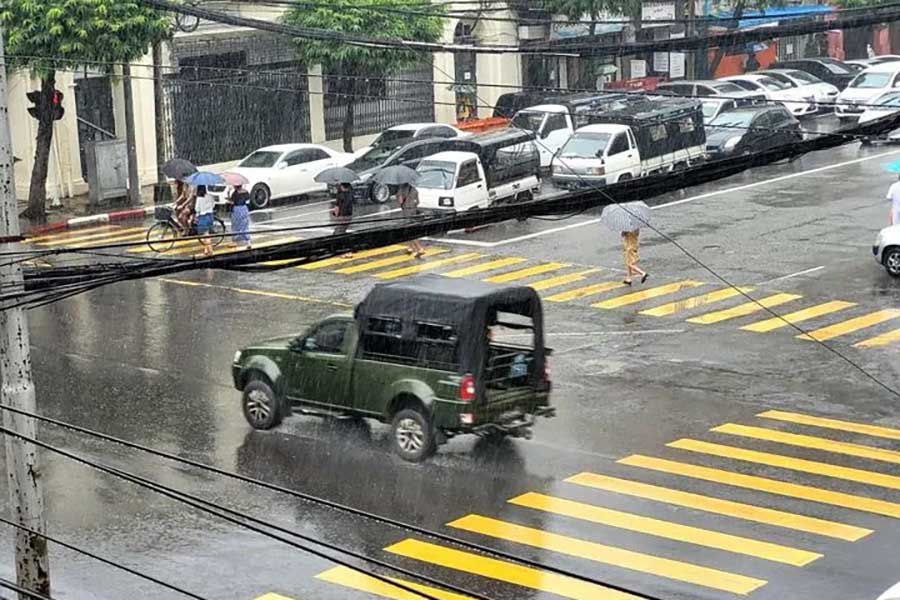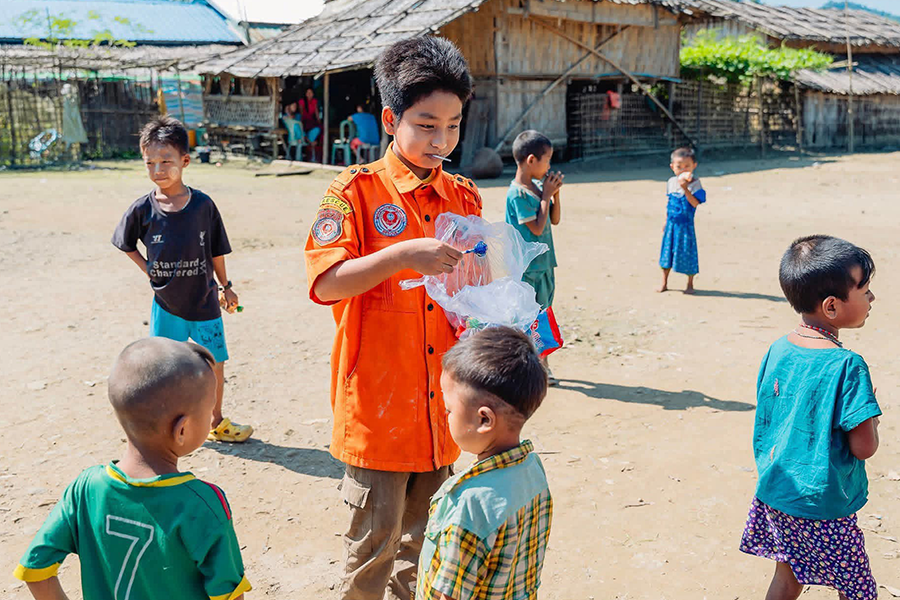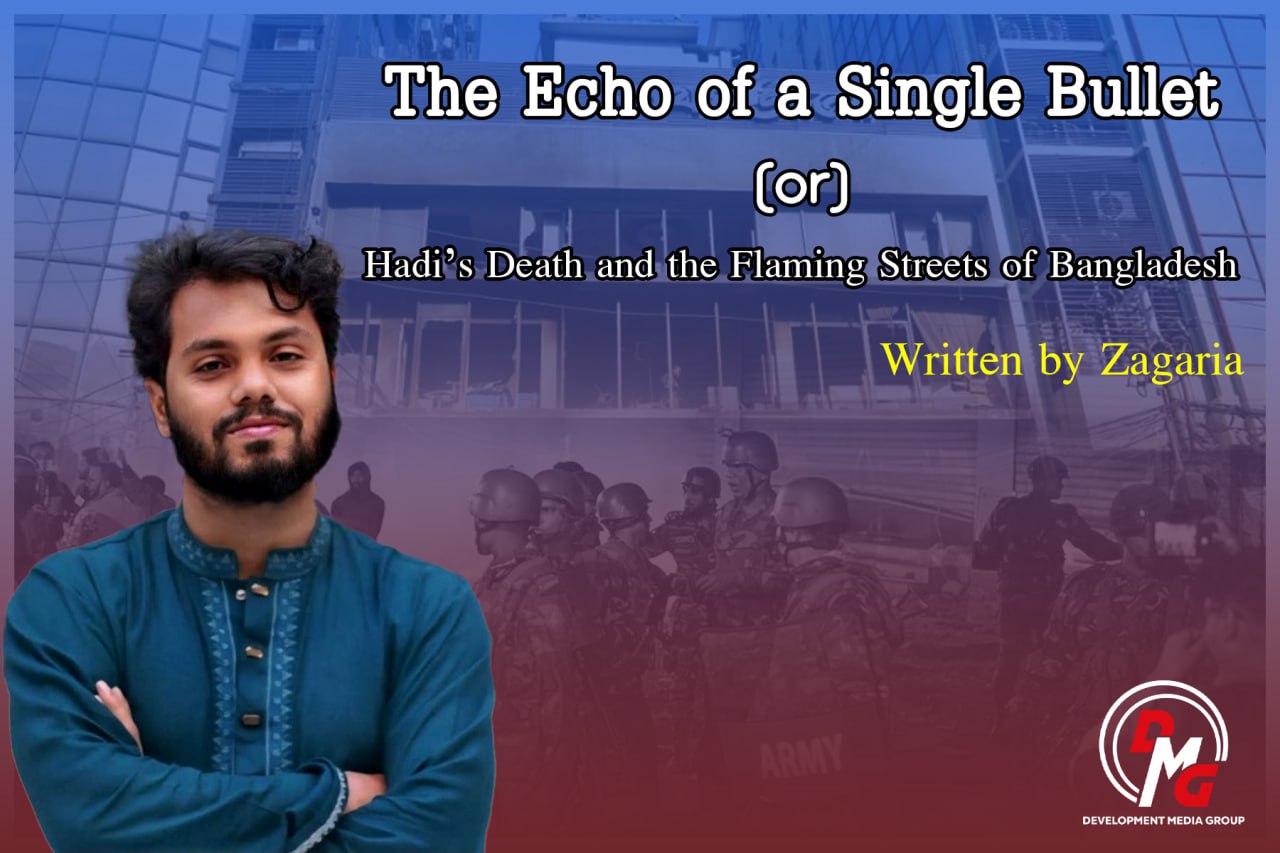- Junta unable to hold elections in dozens of wards and village-tracts in Sittwe, Kyaukphyu
- Fighting escalates between Myanmar military, Arakan Army in Ayeyarwady Region
- Regime steps up civilian arrests in Sittwe
- ULA safeguards Mrauk-U's ancient heritage
- Arakan on the Edge: What the DMG Landmine Impact Report Reveals About Myanmar's Deepening Humanitarian Crisis
When It Comes to Trash, Downstream Issues Are Everyone’s Problem
The Sat Yoe Kya Creek flows south of the Kaladan River to the Minkan River; about eight miles long, and was once a major commercial artery of Sittwe. As the population along the waterway grew over the years, its colour changed, gradually becoming more sullied by household waste and other pollutants, locals say.
15 Mar 2022

Written by Thiha
People are busy at a small harbour where motorboats and other boats dock. Like these people, small waves are crashing on the banks of the creek and under the boats. Various debris, including plastic waste, is moving in countless shapes and sizes in these small waves.
This is Sat Yoe Kya Jetty, one of the most famous ports in Sittwe, the capital of Arakan State. The jetty is also a popular destination for commuters from Sittwe to other townships.
You can see how many people come to Sat Yoe Kya Jetty by observing the rubbish bins at the jetty. If you look at these dumpsters alone, you can see a portion of the waste discarded by the people who come to the jetty, but if you look at the rubbish along the Sat Yoe Kya Creek, you get a decidedly better sense of the amount of garbage generated in this one section of Sittwe alone.
The Sat Yoe Kya Creek flows south of the Kaladan River to the Minkan River; about eight miles long, and was once a major commercial artery of Sittwe. As the population along the waterway grew over the years, its colour changed, gradually becoming more sullied by household waste and other pollutants, locals say.
“When we were children, the Sat Yoe Kya Creek was clear and there was no rubbish. It is very different now,” said Ko Tun Aung Sein, a resident of Sittwe.
In addition to this creek, the Myoe Lae Creek in the centre of Sittwe, which used to be magnificent, is now choked by a lot of rubbish, which is unfortunate for everyone to see.
Arakan State is a coastal region with major rivers including the Naf, Mayu, Laymyo and Kaladan flowing through it. Small tributaries of such rivers flow through towns and villages across Arakan State. You will also find litter at many other jetties along these rivers, streams and creeks, and plaguing the drainage systems of numerous town centres in Arakan State.
Lack of systematic waste management and a lack of knowledge about proper waste disposal have led to careless dumping of waste into the closest waterway. In some cities, local ward administrators have admonished residents not to throw their rubbish on to the creek banks, but rather to throw it into the middle of the creek.
“There is hardly any place to dispose of garbage properly in Pauktaw,” said Ko Kaung Mrat, an executive member of Pauktaw Public Center. “I have never seen the municipality and other organisations educate the public on how to properly dispose of garbage.”
Arakan State is one of the poorest states in Myanmar, and most townships in Arakan State have not yet developed good waste management systems.
“Creeks and rivers, not only in Ponnagyun but also in other towns, have accumulated a lot of rubbish,” said Ko Oo Lwin Myint, secretary-2 of the PNG Development Youth Organization. “Lack of proper waste management could lead to the loss of much of our natural resources in the long run.”
In addition to river dumping, many people in Arakan State are dealing with plastic waste by burning it, another environmentally irresponsible approach to waste management that can lead to air pollution, ozone depletion, climate change, acid rain, and health problems such as lung cancer and asthma.
The environmental group Thant Myanmar warns that dumping of waste into rivers and their tributaries, meanwhile, can result in polluted waters, and damage and depletion of marine life and resources, as well as reduced fertility rates among humans, and stomach, kidney and skin infections.
There are several types of human-generated waste, but arguably most pernicious among them is plastics. As the use of plastic increases around the world, the flow of this material from countless rivers and tributaries becomes a global problem as much of this waste eventually finds its way to the planet’s shared seas and oceans.
Studies of sediment samples from ocean waters and seabeds around the world have shown that microplastics are widespread. Microplastics — defined as plastic pieces less than 5 millimetres in diameter — are prevalent in waters both salt and fresh, as well as in the soils beneath and around our planet’s bodies of water.
Microplastics are the inevitable result of humanity’s growing reliance on plastic. Microplastics are a byproduct of numerous consumer goods, from tyres to toothpastes to T-shirts.
There is reason to be concerned about the increasing presence of microplastics in the waters off the coast of Arakan State. According to a survey by the research vessel Dr. Fridtjof Nansen of Norway, which visited coastal Myanmar in 2018, the amount of microplastics in the Arakan coastal region is comparatively elevated.
Experts point out that the Arakan coast abuts the Bay of Bengal, with coastal neighbours including densely populated Bangladesh and India. Both of these countries’ rivers and streams flow into the same shared bay.
Because seafood is a staple of many coastal Arakan State diets, microplastics tend to make their way into our stomachs. Alarmingly, research has suggested that microplastic particles could allow bacteria to develop a higher resistance to antibiotics.
“Fish and prawns eat the underwater plants. Because these young plants contain microplastics, it is important to be careful about how much people eat these shrimps, considering the food chain,” said Dr. Thaung Htut of the Marine Conservation Society (WCS Myanmar).
Plastics are often dumped into Arakan State’s rivers and streams in the mistaken belief that the rubbish will wash itself away, but in fact it is returning to us in our drinking water and on our dinner plates.
“You have to take care of your own town or village,” said U Maung Thar Sein, a Sittwe elder. “I just want to say that we need to educate people about littering so that we can inculcate the idea that we cannot do it if we do not take care of it ourselves.”

















